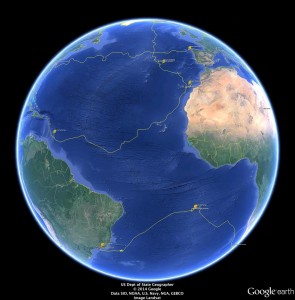On May 18, 2014, scientists and engineers from the Center for Ocean Observing Leadership (COOL) recovered RU 29 off the coast of Ubatuba, Brazil. The Slocum Electric Glider, which is part of Rutgers’ fleet of oceanographic research instruments, spent 189 days at sea traveling from Ascension Island to Brazil. This recent leg of RU 29’s voyage began in November 2013. A previous leg lasted 290 days and took RU 29 on a journey from Cape Town, South Africa to Ascension Island throughout most of 2013. These two legs combined to help RU 29 complete the 10,387 km (6,454 mile) mission across the South Atlantic. Undergraduate students served as the main pilots of this mission, giving direction to RU 29 every few hours as its surfaces.
Building off of the success of RU 27’s crossing of the North Atlantic in 2009, members of COOL are now leading a global effort to complete the Challenger Glider Mission: an two-year initiative to simultaneously pilot 16 ocean-fairing robots around the world’s ocean basins while spreading ocean literacy and educating the general population about our changing planet. COOL is still seeking donors to help purchase additional gliders for this mission.
To date, a mission from Iceland to Barbados by way of the Canary Islands was completed in the North Atlantic by the Slocum Glider “Silbo,” while RU 29 completed its South Atlantic Crossing. Over the next month, RU 29 and “Silbo” will be deployed off of Cape Cod, Massachusetts and Santos, Brazil, to set forth on return journeys across the North and South Atlantic.

